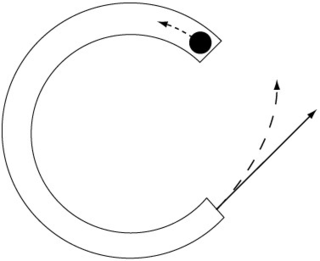Cognition
How We Can Catch a Ball When We Don't Know Where It Will Be
Our minds have two tracks, when it comes to physical motion
Posted September 6, 2017
When a ball comes out of a curved tube, which path will it take?

People tend to think that a ball coming out of a curved tube will continue in a curve. That is, if you ask them, more people will choose the dotted line than the solid one.
This is contrary to actual physics, though. A ball coming out of such a tube will actually go in a straight line.
But there were some studies to suggest that even though people believe certain things about the world, when they act in the world, they don't actually use those beliefs. My former student Jay Jennings and I wanted to see if this were true in this case.
Jay was my undergraduate honours student, and this experiment was his thesis. (At the time of this writing he has his master's and is in progress for his Ph.D. in Cognitive Science.) He built an apparatus that would allow a ball to roll out of a curved tube (this was no small feat--he had many trips to the hardware store!)
He asked one group of people to predict where the ball would go. This replicated earlier findings, in that people often got it wrong. They thought the ball would continue to curve.
But he asked another group of people not to say where they thought it would go, but instead to actually reach out and catch the ball when it emerged. He had them hold their hand still until the last moment, so they would not be able to track the ball as it moved.
As predicted, people did just fine on this task. They reached for where the ball would be, rather than where they would have told you it would have been!
What does that mean? Well, the motor system has its own "understanding" of physics that our conscious minds do not have access to. The ideas we have about how physics works are theories in our minds. But the motor system has it's own system to make predictions and process them to guide our bodies.
We presented this work at the Cognitive Science conference in London in the Summer of 2017. You can read the paper by clicking the link below.
http://jimdavies.org/research/publications/cognitive-science-conference/2017/JenningsDavies2017.html
References
Jennings, J. & Davies, J. (2017). The motor system does not use a curvilinear belief: Folk physics and embodied cognition. In G. Gunzelmann, A. Howes, T. Tenbrink, & E. J. Davelaar (Eds.),Proceedings of the 39th Annual Conference of the Cognitive Science Society (pp. 2296—2301). Austin, TX: Cognitive Science Society.


